DigitalDeepak SEO Case Study: How I Get 1000+ Free Users a Day

I have been in the digital marketing field for more than 10 years. I have mostly specialized in designing and executing marketing funnels for B2B and B2C brands. To design a highly efficient marketing funnel, one needs a good command over paid advertising, marketing automation, copywriting and most importantly, SEO.
SEO and paid advertising helps me get more people at the top of my marketing funnel. I love paid advertising because it is targeted and scalable. I invest in paid advertising, as long as I am getting the ROI. However, paid advertising has one down side – you have to pay for the traffic. And you are not creating an asset that will bring traffic for a long time to come.
Creating content assets and attracting organic traffic from the search engines is one of the best ways to get target customers into the top of your marketing funnel. Investment in content and SEO gives long term disproportionate returns. As the saying goes, “You reap what you SEO.”
Having a strong content and SEO strategy also helps me identifying content and keywords that I can promote via paid advertising. I am also able to build high quality landing pages which get a high quality score in Google Ads because for ranking in the search engines, a high quality landing page is a must.
My first set of customers discovered me through organic search. The quality of the users who come from organic search is very high.
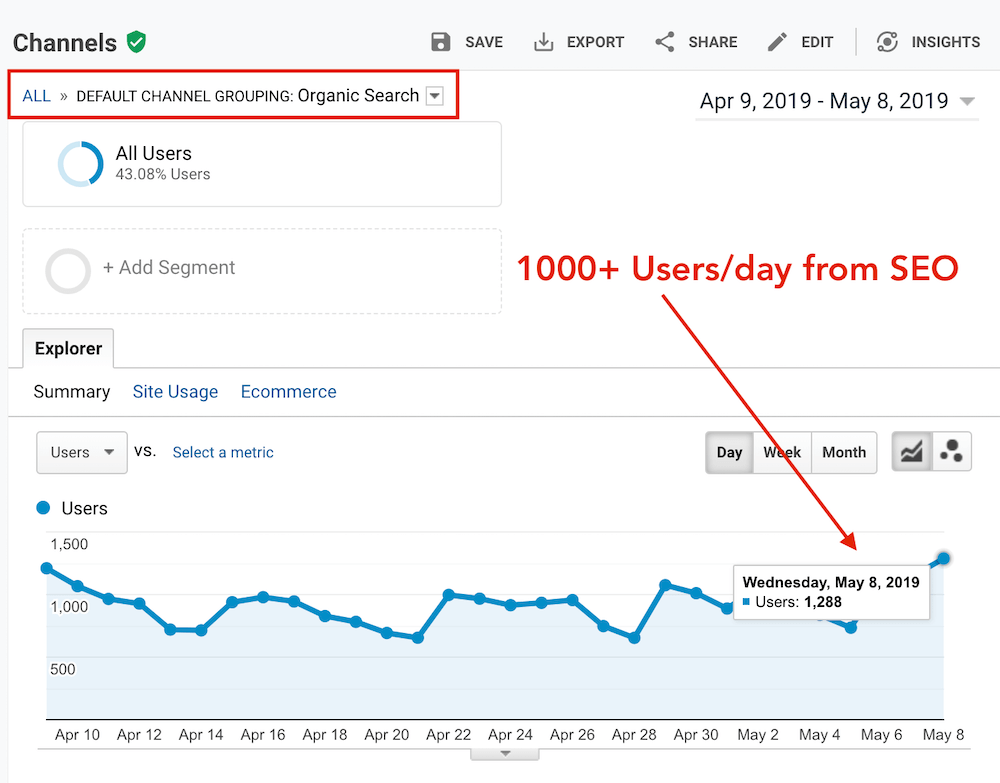
The above screenshot from my Google Analytics shows that for the past 30 days, my blog has been receiving 1000+ users a day from Organic Search, consistently. In fact, on Mondays and Tuesdays, it nearing 1200+ users a day.
Creating content to full fill the demand on search engine users has a high return on investment. Each piece of content that you create becomes as asset that brings returns over time. Even if you stop posting new articles in your blog for a while, you will notice that the traffic doesn’t disappear overnight.
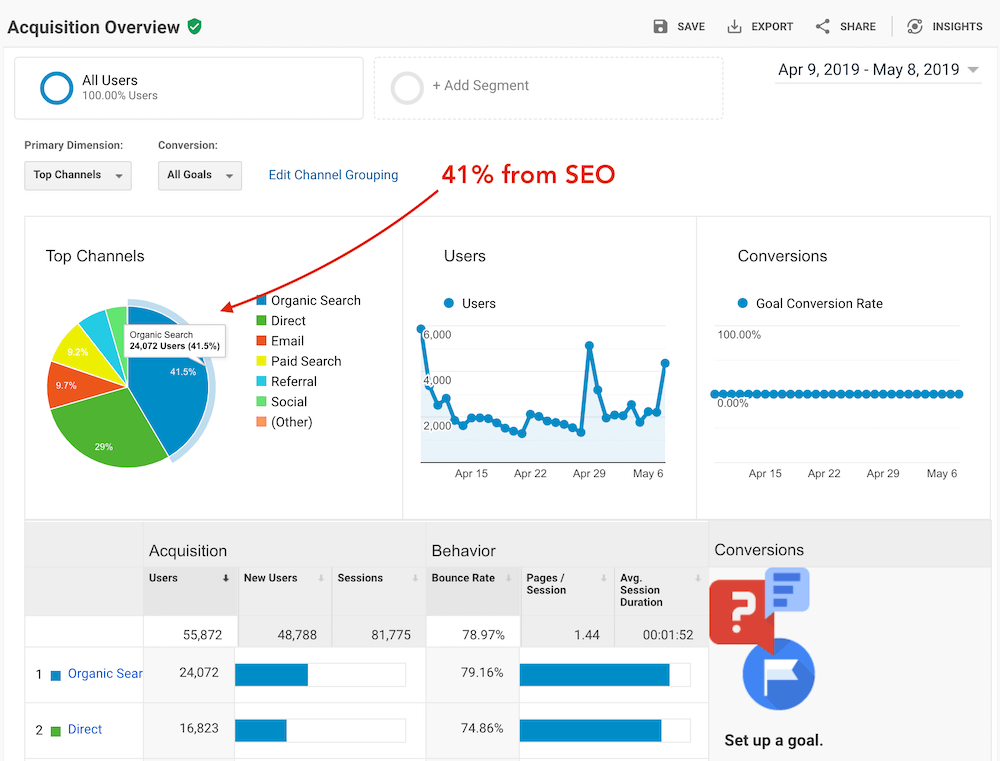
You can see that over 40% of my blog’s traffic in the past 30 days has been from Organic Search, mostly from the Google search engine.
This is a healthy split for any website. I would recommend that at least 30% of the traffic should be from organic search for any web property.
In this article, let us have a look at all the things I have executed in the past 5 years to get my organic search traffic to this level. And the things I plan to do to increase my organic search traffic to 10,000+ users a day.
1. Start Early with a Good Domain Name
Domain names age like fine wine. The older the domain name is, the more authoritative it is. I registered my domain name DigitalDeepak.com in 2013, and since then I have been blogging 2-3 articles a month until now.

I started making revenue with DigitalDeepak only by 2016 when I launched my own courses. For nearly 4 years, I was constantly updating my blog with 2-3 articles a month consistently without any immediate return on investment.
A good domain name that is regularly updated with fresh content makes it a valuable web property, because it attracts high quality attention of the internet users who could potentially become your customers.
You will not be able to monetize the content until you build a product that you can sell it to your users. Once you have a product that your users want, you will be able to generate profits from your visitors, and reinvest the money back into content creation.
To grow traction for my content in the initial days of my blog, I shared my published articles on my LinkedIn profile, Twitter and Facebook. Then I created a Facebook Group for digital marketers and started sharing my articles with my followers in the group.
Once in a while, someone would link to my articles from a forum or a blog post. And these initial links were very important to help me get ranked for some of the keywords I was targeting. The domain authority and backlinks started building over time as I published more content, and started getting more traffic.
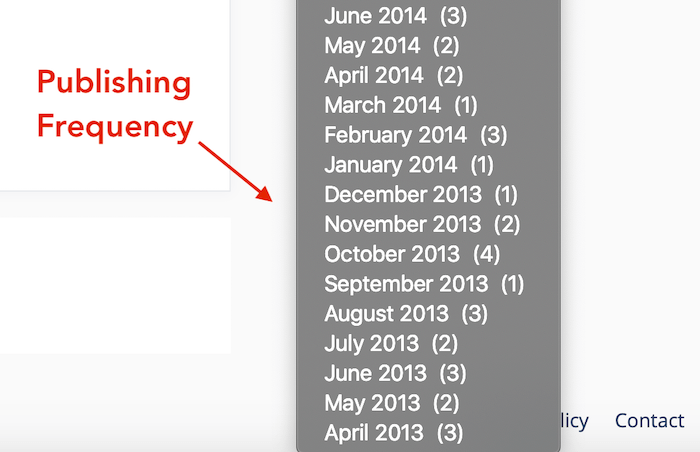
Building a web-property with a focus on SEO is like growing a tree. The best time to start a blog was 10 years back, the second best time is today. Do not underestimate the power of a few good articles on a domain name. They end up getting traffic and links over time.
If you are planning to start a project a few years down the line, start building your presence now. If you have already got a domain name, great. If you haven’t, register a new domain name, or purchase a premium domain name and start publishing content. Install Google Analytics and start tracking your traffic. Keep adding content regularly. Even one good article a month is going to matter a lot in the future.
Keep sharing all your articles on your social media handles. Get a few backlinks through PR and guest contributions. Links that are earned with good content early on can help you a lot in getting SEO traffic in the future.
2. Publish Authoritative & Research Based Articles
Everyone on the web has an opinion. Anyone can start a blog and talk about what they think about something.
Usually opinions do not get much traction on the web unless it is coming from a very authoritative personal brand and is very polarizing.
Mostly, opinions do not have much value. Anyone can disregard your opinion, copy your opinion and publish their own opinions on their blog. There is no need to refer to you, or link back to you.
However, if you publish authoritative, research based articles, people have to refer you when they talk about it. They will link back to the source. Even if your article doesn’t have numbers and data, it should have solid references on which you have built your assumptions. You can see that even this article has a lot of data backing up my claims.
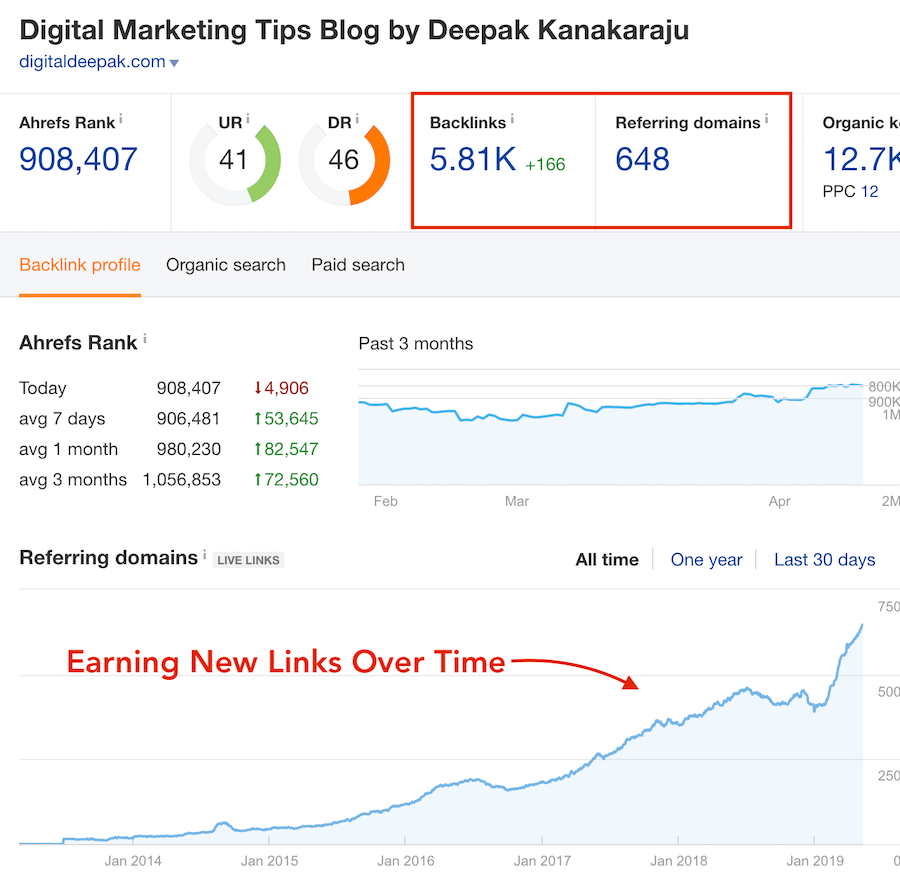
You can see from the above Ahrefs screenshot that I have got 648 different linking domain names to my blog, and a total of 5,800 backlinks from all the domains combined.
And the total new domains linking to my blog has been on an exponential growth curve. The organic traffic value according to Ahrefs is more than $25,000 for the past 3 months. My web asset is giving me good returns in terms of quality traffic – which I would have to pay for if they did not come to my blog through search.
The more data backed posts I published, the more links I get. And the more links I get, better is my SEO.
One of the most linked to articles on my blog is an article on Drip Marketing. Even though I have written my thoughts and opinions on drip marketing, I have mentioned a lot of data from a lot of authoritative sources like Marketo, Marketing Sherpa, IBM, Gartner research, and so on.
Apart from my thoughts and opinions, I have added screenshots of actual data and what is happening behind the scenes. Such data is hard to argue with and naturally becomes authoritative.
When the content is well structured and appealing to the readers, it has a higher chance of earning backlinks naturally because people want to refer it to other people. There is no need to build backlinks for SEO, because you will be earning links, naturally.
To give you another example, check out this blog post: Do Digital Marketing Jobs Pay More Salary? Data Says Yes
The article is completely backed by data from various sources. I have not created the data myself, but since I have curated the data, the post becomes authoritative. By the way, I have also linked to the data sources that I got the data from. That’s the way we pay it forward in the blogosphere.
You can either curate data and add opinion to it, or you can create the data yourself. It is harder to create data, but once you have some followers, you can create new data through surveys and research.
I did a survey among my audience to find out the state of digital marketing talent in India. The post is made from the data that I have created myself through research. Such posts have a very high chance to earn backlinks.
This blog post is also based on data. I am showing you real numbers from my Analytics dashboard, and hence my opinion has more weight. If I had talked about the different ways you can improve your SEO without showing you the proof that I have already done it, you wouldn’t take my suggestions seriously. I am not giving you my opinion. I am giving you facts. You can ignore opinion. You can’t ignore facts.
3. Optimize for Reader’s Experience and Page Load Speed
When your website users are reading content on your pages, it has to be a pleasant experience. This means that the page should have good design, good layout, good content, and more importantly, the page should load fast enough so that your website visitors do not bounce off in the first second or two after waiting.
A page with hardly any content will probably get a very high score in the page speed test, but we need to provide people with good content as well. A functional website like Google.com where the first step is to search for something can have a very high page load speed. We need to strike a balance between content and page load speed.
There are three tools that I frequently use to check the performance of my website in terms of page load speed. They are:
- PageSpeed Insights by Google
- Pingdom Website Speed Test
- GTMetrix Page Speed Performance Analyzer
Out of the above three tools, the most important score to consider is PageSpeed Insights.
I recommend having a score of 70+ in PageSpeed to make sure that your website is optimized well for SEO.
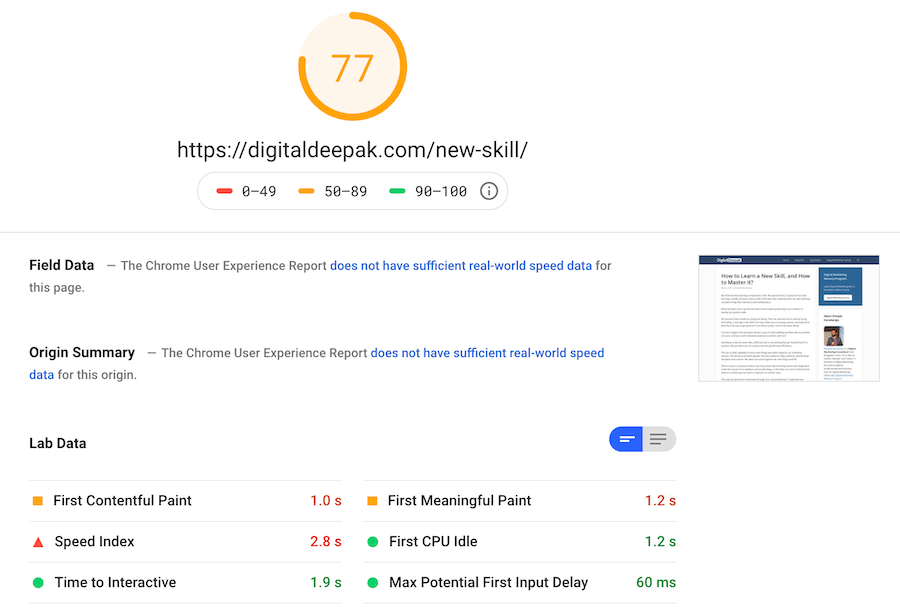
If you are using WordPress, the theme should be light weight and should be able to load fast on the website.
Whenever I upload images, I make sure I compress them before uploading. I use TinyPNG.com to compress the images and the images usually come down to 1/3rd of its original size.
I also use WPX Hosting, which is one of the best managed WordPress hosting companies out there. WPX Hosting takes page load speeds for SEO very seriously and the founder is a veteran SEO expert himself.
4. Long-tail Content Strategy for SEO
A website’s traffic is almost never to the homepage alone. Most of the traffic comes to internal content pages directly from search and links from other websites. This is the power of long tail.
If you rank different pages for a lot of long tail keywords, you will be able to have some traffic for each of the pages targeting a different set of keywords. All the pages combined will help you increase the traffic to your website.
If I login into my Google search console, I can see that I’ve got more than 70,000 clicks for free from Google search for free in the past 3 months.
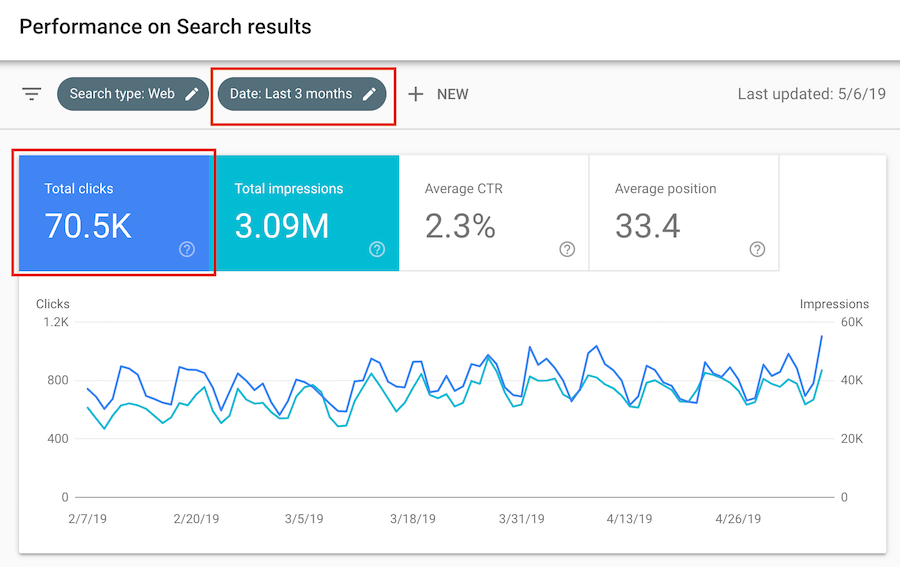
All the clicks are earned by different internal pages. If you look at the top pages that are driving traffic to my blog, you can see that some pages get even more traffic than the homepage.
Each of these pages target a different set of keywords and get traffic from the people searching for those keywords.
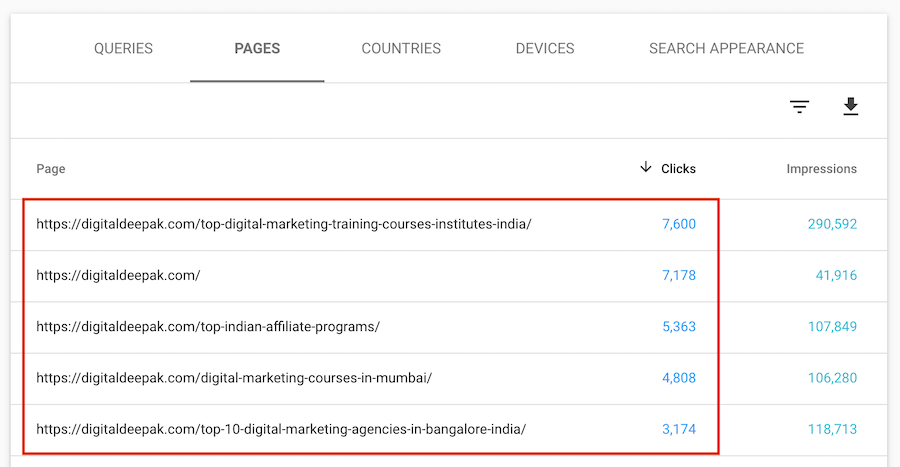
Short-tail keywords are in general harder to rank because the competition for such keywords is very high.
If you target long tail keywords, the search volume for each of these keywords will be lesser than their short-tail keywords, but you will be able to rank easier, because the competition is very less.
I have tried to target both short tail keywords and long tail keywords and my return on investment on creating long tail keywords has been very high.
For example,
- the keyword “digital marketing” is a very short tail keyword. It is very hard to rank for it.
- “digital marketing courses” is a medium tail keyword.
- “digital marketing courses in india” is a long tail keyword.
- “digital marketing courses in mumbai” is a long tail keyword will lesser competition
I would be very happy if I can rank No.1 for “digital marketing” but that day is very far away. There are a lot of websites with a lot more backlinks than me ranking for that keyword. It will be very difficult, if not impossible to rank on top for such a short tail keyword.
I want to target medium tail keywords like “digital marketing courses”, but I cannot rank for them on the top 10 easily. I need more time and more domain authority before I can do that. But it is definitely easier than trying to tank for 2 word keywords.
I rank on the top 5 results for the keyword “digital marketing courses in india” but since I am not ranking No.1 or No.2, I am not getting THAT much traffic.
I rank No.2 for the keyword “digital marketing courses in mumbai” and it gets me a LOT of traffic. High quality, targeted traffic that can potentially convert into customers and students of my online digital marketing courses. That’s a good return on investment to have on the content created.
My page that is ranking for “digital marketing courses” has got 7,600 clicks in the past 3 months. The page that ranks for “digital marketing courses in mumbai” has got 4808 clicks. That’s almost 60% of the traffic from the medium tail keyword.
So now, the total traffic I can get for targeting all the following keywords will be much more than what I can get for “digital marketing courses”.
I can target keywords like:
- “digital marketing courses in mumbai”
- “digital marketing courses in bangalore”
- “digital marketing courses in chennai”
- “digital marketing courses in delhi”
- and more…
I can publish one article each for each of the medium-tail keywords and rank No.1 easily for all those keywords – because the competition for long tail keywords is very less.
Discovering Long Tail Keywords
To find out long tail keywords, the easiest way is to use Google’s auto suggest.
If you go to Google.com and type in 3-4 words, Google will auto suggest long tail keywords. If I search for “digital marketing courses in” Google will auto populate the top words that are being searched after these 4 words.
Even better, I would search for “digital marketing courses in a” and then Google will auto suggest all the keywords that start with a.
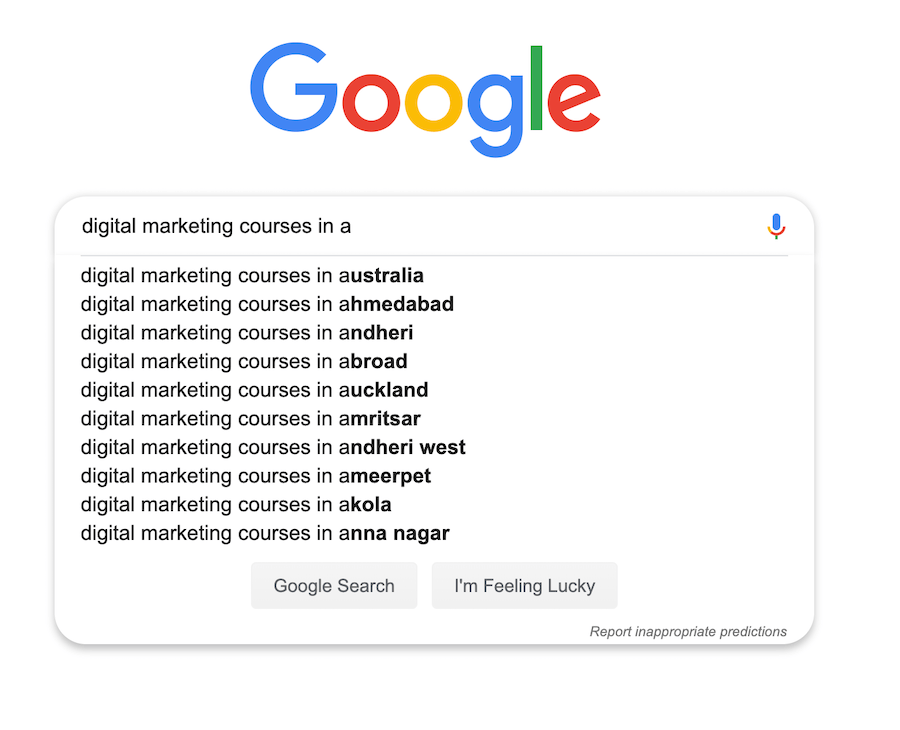
I can then do another search like “digital marketing courses in b” and we will get more results of long tail keywords with the 5th word starting with b.
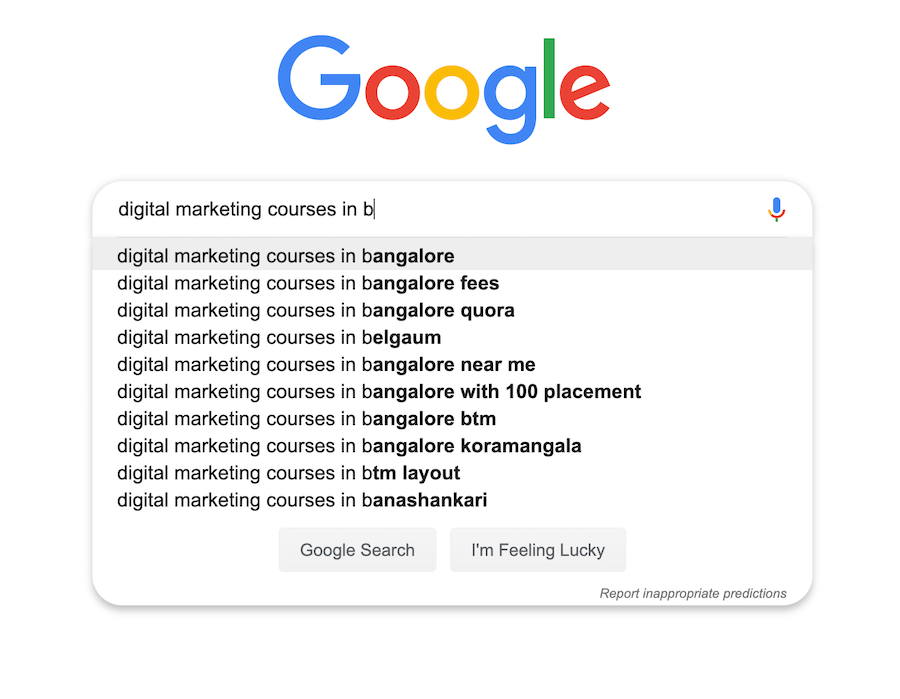
You also have to make sure that each of these keywords have descent search volume.
For example, I wouldn’t publish an article for “digital marketing courses in bangalore koramangala” yet because it is a very long tail keyword, and the investment in creation of content will not justify the ROI in traffic, yet. However, in the future, the search volume for specific keywords might go up, and when I rank for those keywords, I would get profitable traffic back to my blog.
Apart from Google’s auto suggest, there are many more ways to come up with keywords that you can target.
The top ways I come up with new keywords that have good search volume are:
- Google’s auto suggest
- Fetch keywords from Search Console. Target keywords that you have no targeted pages for but are ranking anyway. Target keywords that have very high impressions but no clicks.
- Run a Google Search Ad, and fetch keywords from the search term report.
- Use KeywordTool.io
- Use UberSuggest
- Use Ahrefs
- Use Moz
You can also find out new keywords by looking at what your competitors are ranking for. Many tools like Ahrefs will give you data about your competition.
Ahrefs collects data by crawling the web just like Google does. And they can find out what are the top pages on your competitor’s websites that are getting traffic from the search engines via long tail keywords.
For example, let’s take a look at the data from my competitor Sorav Jain. (He also happens to be my good friend).
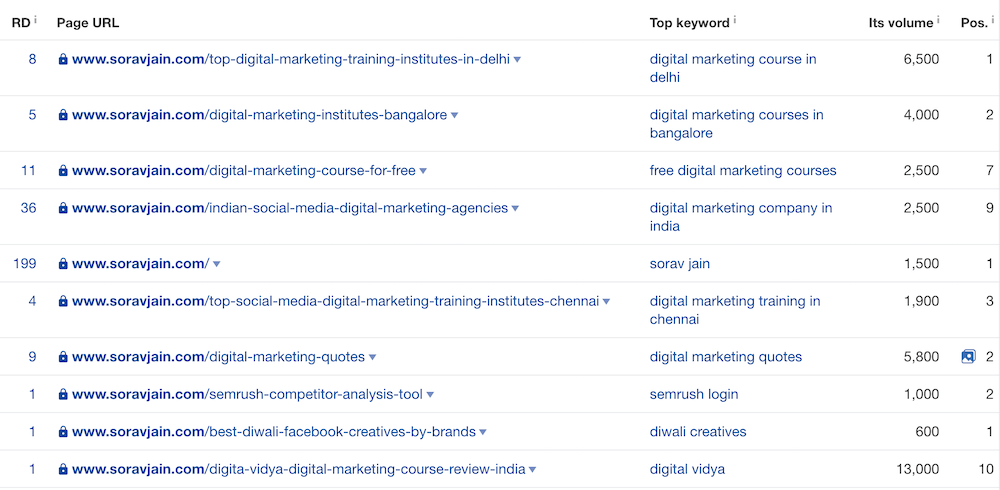
I can see that he is getting a lot of traffic from long tail keywords.
I do not have pages targeting many of these keywords, yet.
When I invest in content creation for my blog, I can go after the low hanging fruits, discovered through competition research.
There are many interesting keywords in the above list which I did not think of earlier like…
- “top digital marketing agencies in India”
- “digital marketing quotes”
You can see the left most column as “RD”. RD means ranking difficulty. Higher the number, tougher it is to outrank them.
When certain pages have a lot of backlinks, the ranking difficulty goes up. For example, the keyword “sorav jain” has a very high ranking difficulty. And the number of backlinks he has for the home page URL with “sorav jain” as the anchor text is very high. There is no way I can rank DigitalDeepak.com for the keyword “sorav jain”. Neither do I want to. However, there are many other easier keyword opportunities.
A combination of keyword research tools, Google’s auto suggest, research on the competition’s traffic will give you enough keywords that you can target and rank for. Having a data-driven, keyword research based content strategy is the best way to increase organic search traffic in the long term.
As you keep building your site’s authority over time, you will keep earning new backlinks and that will lead to a higher domain authority. With high domain authority, you can rank for the long tail keywords even without having to build links to those pages separately.
Write for Your Readers
Having said all this, never write content for the sake of ranking in the search engines. Always write content for your readers and make sure that you are delivering value with your content. Without having a focus on giving value through content, you will never be able to attract backlinks and rank for these keywords.
If your content is not of good quality, search engines can easily find that out and lower your rankings. For example, if my article on “digital marketing courses” is not of good quality, someone who clicks on my website link and enters my page, would just click the back button and try some other result.
Google knows that this person has bounced back, and because of that, they know that your content quality is not that great. You will not be able to have a high enough ranking to attract enough clicks from the searches for that particular keyword.
You need to be data driven in finding out the demand for content through proper keyword research. Once you have finalized on the keywords that you want to target, write articles for readers that they can read and gain value from. Without adding value through content for your readers, you will never build a strong personal brand.
Talking about personal brands, let’s have a look at the most important SEO and content marketing strategy that most people often ignore, or even forget about…
5. Grow Your Personal Brand and Authority
It doesn’t matter if the website is a personal blog or a brand’s website. The people who create content are people end of the day, and readers want to read from real people. The personal brand and authority of the author matters a lot when it comes to the perceived value of the content.
This blog DigitalDeepak.com has almost all the articles published by me.
You are reading these blog posts not because it is published on DigitalDeepak.com, but because it is written by me. You would be equally interested in what I have to say if I had delivered the same article as an ebook, or if I had published this article on some other website.
You do not care about the website – DigitalDeepak.com. You are paying attention because of who I am and what I want to say. That’s why it is important to focus on personal branding and growing authority. This is part of your SEO strategy.
A while back, Google introduced something called Authorship, where you had to link your author profile to the article that you have written, and Google would show your author profile picture next to the search results. As of now, the authorship snippet doesn’t exist anymore.
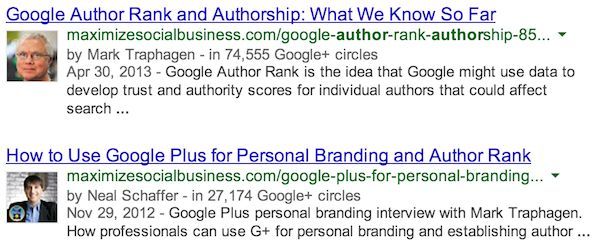
When Google had launched authorship, another important keyword made rounds in the SEO space – Author Rank.
Author rank is an idea that Google will be using the data it collects from the web to rank individual authors based on their expertise. It is still a hypothesis, and it is not yet proved that Google has some data point called author rank, but there is no reason why you shouldn’t focus on building your personal brand.
Even if Google is not trying to rank authors according to their expertise level, you are still going to have a lot of incoming traffic to your blog through brand searches. I get 1000s of clicks per month to my blog with the search term “deepak kanakaraju”. This is because of personal branding and word of mouth marketing.
Here are the different methods that I follow to grow my personal brand and possibly my “author rank”.
- Publishing books in my name
- Gave a talk on the TEDx platform
- I give talks at events and conferences whenever possible
- Add useful videos to my YouTube channel
- Participate in interviews and podcasts when people invite me
- Guest post on authority publications like Entrepreneur.com and YourStory
- Contribute articles to fellow bloggers in my industry
- Conduct AMA sessions on Facebook Groups and Forums
- Post small bits of ideas, inspiration and thoughts across all my social media channels
- Answer people’s questions on Quora, Facebook Groups, LinkedIn groups and niche forums.
- Conduct webinars and participate in other people’s webinars.
When you are perceived as an expert in your industry, people will not hesitate to link to you, quote you and invite you for sharing your thoughts on their platform. Building authority and expertise on a subject is a side effect of wanting to learn, grow and help other people learn new skills & get new opportunities.
I already seem to have good search volume for the keyword “deepak kanakaraju”. Google even suggests words for my keyword. This is a side effect of the value I have created with my content.

When you become a known personal brand and position yourself as an authority in a specific subject, you will find it easier to get clients, get job offers, and find it easier to convert your blog readers into customers.
Your preeminence will help you increase your conversion ratios across all the stages of your funnel.
Use Your Personal Brand to Grow a Brand
Your personal brand and authority will then rub off on the brands that you have created and make it a valuable brand.
For example, Steve Job’s personal brand got rubbed off on Apple, Elon Musk’s personal brand rubs off on Tesla and SpaceX, Rand Fishkin’s personal brand rubs off on Moz.com. Over time, the brand(s) that you have created will become preeminent by themselves.
Your personal brand can be used to increase the preeminence of the brands that you create, but in turn, the brands that you create, can rub off their preeminence on other associated personal brands as well.
For example, I have positioned myself as an expert in Digital Marketing. My performance marketing company – PixelTrack also becomes preeminent because of me. My co-founder of PixelTrack, Sanjay Shenoy builds his personal brand through me, through PixelTrack and becomes preeminent.
When people talk about SEO, they get lost in the technical terms. Yes, backlinks, on-page SEO, keyword research etc. are important but the most important of it all is to build a brand.
A strong brand will naturally benefit SEO in every possible way. Google will reward brand mentions and sites with a lot of brand searches. People will not hesitate to link to a well-known brand. People will be more likely to click on a well-known and trustworthy brand on the search results and social media feeds than other brands.
For example, if you see an ad for the latest Search Advertising Tips on your Facebook Feed from two different people, one is someone that you do not know, and the other person is DigitalDeepak, which ad are you more likely to click on? My ad of course. Because you have heard about me before and you are confident about the quality of the content I create. Even if the other ad performs better on a blind split test, I might be able to get a higher CTR just because of my brand recall.
Out of all the above 5 ways I’ve mentioned that helped me increase my organic traffic, building a brand is what has helped me the most in SEO. It might look counter-intuitive, but it’s the truth. You have to align your marketing and branding strategy to build trust among users and that’s all it takes to win in the SEO game.
Final Words
I hope this detailed case study has helped you get insights into my SEO strategy. This is the same strategy that we follow for all the clients of PixelTrack. This is the same strategy that I teach in detail in my SEO mastery course.
I plan to follow the same strategy to get to 10,000+ users a day from organic search. And I hope I will achieve it within a few years. I will update this article when I get there.
If you have any questions, please leave a comment below! I reply to every question.